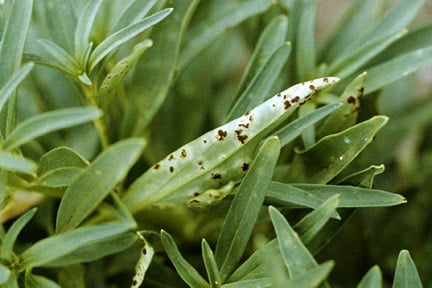
Quick facts
Common name - Antirrhinum rust
Scientific name - Puccinia antirrhini
Plants affected - Antirrhinum
Main symptoms - Yellow spots on the upper leaf surface, dark brown pustules on the undersides
Caused by - Fungus
Timing - Late spring to autumn
What is antirrhinum rust?
Antirrhinum rust is a disease caused by a fungus (Puccinia antirrhini) that spreads by airborne spores. It is specific to antirrhinum cultivars, although some claim to be resistant (see 'Control' section below). Expect to see it from late spring to autumn.
Symptoms
You may see the following symptoms:
- On leaves: Initially, pale yellow spots appear on the upper leaf surface, corresponding to dark brown, dusty pustules on the lower surface. Later, leaves shrivel and vigour is greatly reduced
- On stems: In severe infections pustules can also be produced on stems, and dieback may occur
Control
The RHS believes that avoiding pests, diseases and weeds by good practice in cultivation methods, selection, and encouraging or introducing natural enemies, should be the first line of control. If chemical controls are used, they should be used only in a minimal and highly targeted manner.
Non-chemical control
Prompt removal of infected leaves early in the season may delay the build-up of the disease slightly, although weather conditions have the greatest influence over the speed of spread. Dispose of plants at the end of the season.
'Resistant' cultivars are available, although the rust can usually adapt to and overcome this resistance. ‘Coronette’, ‘Monarch’ and ‘Tahiti’ series have all been claimed to be resistant.
Fungicides
The RHS recommends that you don't use fungicides. Fungicides (including organic types) may reduce , impact soil health and have wider adverse environmental effects. If you do intend to use a fungicide, please read the information given in the link and download below to ensure that use, storage and disposal of the product is done in a responsible and legally compliant manner.
The products listed in the ‘Fungicides for gardeners’ document below are legally available for use by home gardeners in the UK. This information is provided to avoid misuse of legal products and the use of unauthorised and untested products, which potentially has more serious consequences for the environment and wildlife than when products are used legally. Homemade products are not recommended as they are unregulated and usually untested.
Download
Fungicides for gardeners (Adobe Acrobat pdf document outlining fungicides available to gardeners)
Link
Biology
The fungus originates from western North America on related species, but proved highly infectious to the European Antirrhinum majus when accidentally introduced to the UK and mainland Europe in the last century. It releases dark brown spores from the pustules on the lower leaf surface and these are spread by the wind to initiate new infections on leaves.
The rust fungi are described as biotrophs; that is, they grow within the living tissues of the plant and extract from the cells over an extended period. However, although they do not kill tissues rapidly, heavy attacks by rusts can cause tissues to collapse and die prematurely and this is the case for antirrhinum leaves. This leads to a great loss of vigour and an unsightly plant.
Occasionally, overwintering resting spores are produced by antirrhinum rust, but these are relatively unimportant and the fungus principally survives from one year to the next on infected plants. Under favourable, wet conditions the disease can build up rapidly and is often unnoticed in the early stages because it usually starts on the lower leaves. Like many rusts, the full life cycle requires alternation between two unrelated plant hosts, but in Europe only the stages on antirrhinums occur.
Antirrhinums may also be affected by powdery mildew and, particularly on wet soils, by root and foot rots, but these problems are of relatively minor importance compared with rust.






